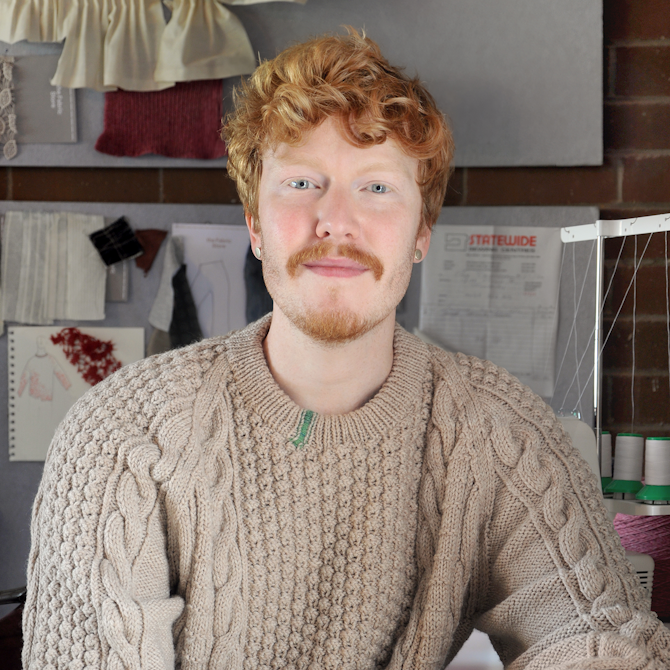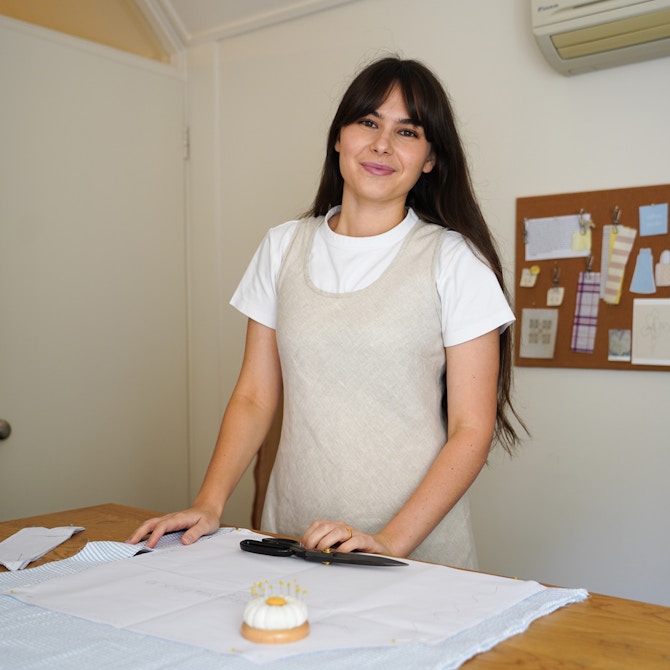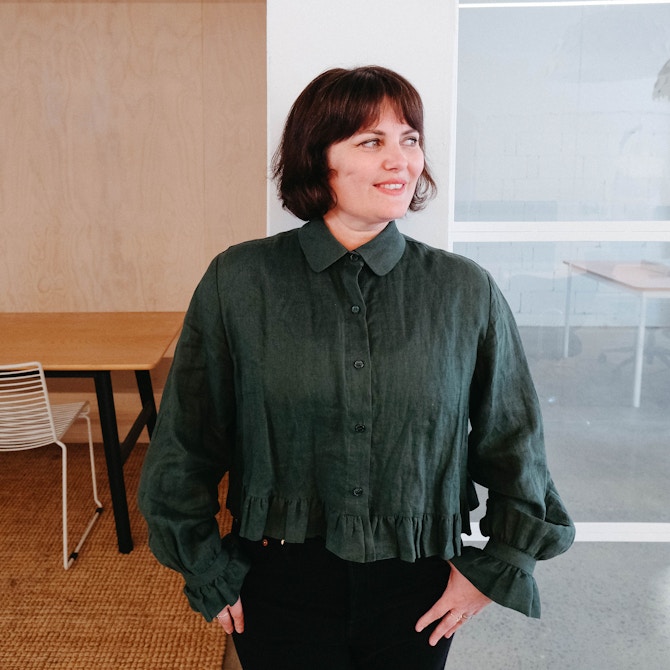Friends of TFS

Guy Dempster
30—April 2024
Read our interview with circular designer and textile enthusiast Guy Dempster!
This week on Friends of TFS, we catch up with Guy Dempster, designer, textile entrepreneur and craft enthusiast! A member of TFS Melbourne store team, we're super proud to see Guy taking his talents into the world of sustainable fashion and circular textiles through his design practice Dempstah. We caught up with Guy recently to chat about all things sewing, and what he's up to at the moment. Read on for more!
I’m Guy! I’m a designer, crafter and textile nerd. My background is in knitwear and knitted textile design, and in 2019 my partner Otis and I co-founded Dempstah– a circular design practice recycling Australian textile waste into spun yarn.
I’m from Sydney originally but spent the better part of the twenty tens studying and working abroad– in New York, Shanghai, the UK and Hong Kong– before moving back to Australia several years ago, and relocating to Melbourne just last year!

I’ve been sewing on and off since I was a kid. I started to show an interest in fashion and textiles very early on, and was always obsessively drawing outfits and designs– inspired by the fantastical characters in Saturday morning anime shows and comic books, Renaissance and pre-Raphealite art, and Fran Fine from the Nanny.
My parents were wonderfully receptive and decked me out with a mannequin, sewing machine and let me turn an attic room in our house into my own little studio, and by the time I was 14 I was spending every Saturday at a dressmaker’s shop in Paddington earning pocket money while learning the ropes.
I eventually went on to study fashion design at The Fashion Institute of Technology in New York, and then on to Nottingham Trent University in the UK to specialise in knitwear.




Dempstah is very much an experiment in circularity.
Otis and I have spent the past five years working with a small network of international and local mills learning how to turn textile waste back into new materials, in practice.
The method of recycling we’ve engaged is called mechanical fibre recovery, which uses various milling machinery to comb and tease fibre from waste fabrics. This fibre is then blended and spun into yarn to create new textiles.
We’ve produced several ranges of yarn over the past few years; upcycling fashion industry post-production waste (offcuts and scraps), before moving on to recycle more diverse, complicated post-consumer clothing and homewares.
We’ve stocked our yarns with about 10 different craft and textile stores around Australia (and are about to launch with our first New Zealand stockists: online sustainable textile boutique Paper Scissors Cloth), and wholesale yarns to indie brands and designers to make their own knitwear.




Just last month Dempstah won eBay Australia’s first Circular Fashion Fund, which came with a $100k award and ongoing industry mentoring. Our pitch for this award, and ultimate vision for the business, is to purchase a small scale fibre recovery machine line, to keep and run on land my family owns in North West Tasmania. We’re calling it the Dempstah micro mill!
It’s a lofty, long term project but a necessary one if we want to develop a deeper understanding of this recycling process and its applications. We’re keen to join the small but dedicated landscape of local players trying to kickstart a healthier, more circular Australian textile milling industry.







I have this big chunky cotton knit sweater that has been all over the planet with me, that I still adore and pull out every winter. I bought it when I was 15 at my local Vinnies. It has this complicated, slightly gaudy, abstract intarsia pattern all over it in earthy browns, reds and black. Every season I have to thread up a wool needle and sew some part of it back together that has inevitably unravelled. At this point it’s deeply comforting– we’ll celebrate our 20th anniversary together next year!


One of my recent successes was an oversized drop-shoulder top I made with a beautiful linen/modal jersey from The Fabric Store, in a taupe grey. It’s such a basic piece, but I think I toiled about 2 or 3 iterations before getting the proportions right, and now I can’t wear it enough. I’ve since bought the navy colour of the same fabric to make another. It’s the perfect cut and shape I’ve always dreamed of wearing but never found readymade.
This one project has really shifted my approach to making clothes. With my background in design, I’ve always approached sewing projects with the intent to realise a unique design idea or showcase a special fabric or technique, rather than focusing on what I (or whomever I’m making stuff for) would actually wear the most. I will say the former approach is perhaps a bit more creatively gratifying, but clothes aren’t just for showcasing creativity, ideally they should also be practical and maintain your desire to wear and live in them for as long as possible. So I guess I’m now gravitating more towards wearability and away from novelty.


Ahh jeez there are too many to count… accidentally ironing synthetic gazar on the highest heat (it melted), accidentally hot machine washing a natural wool knit (it felted), and countless gaffs sewing pieces together back to front and inside out.
I think the most teachable fail was my seminal attempt at pattern making when I was a kid. I remember spreading out two layers of cotton poplin fabric on the floor, pinning them together, and without a ruler or tape measure in sight began cutting out ‘the shape of a dress’ which was essentially an hourglass of cartoon-like proportions.
I sewed up the side seams– no closures or zips mind you– and was then deeply frustrated when it proved near impossible to get the thing onto my mannequin.
After some wrestling I stood back to assess my couture masterwork, only to be further bamboozled by the misshapen, unwearable abomination before me.
The experience taught me that making clothes required more than just vim and verve, and as this was a time before Google and Youtube, I impatiently awaited our next family visit to the local bookstore to seek out answers in the craft and fashion section.


I’ve been sewing with a lot of knits/jerseys recently, using both my overlocker and Bernina sewing machine with a 2.5mm twin needle. I’ve had several people tell me they find twin needles too finnicky to use, and that they can’t avoid the fabric forming an unattractive tunnel between their twin lines of stitching.
I had this same problem when I started using the twin, and after some trial and error discovered the problem was my bobbin tension!
You need to loosen it considerably compared to normal, single needle stitching. I now turn the flathead screw on the side of my bobbin case a good 90 degrees to loosen the tension, and find anything less won’t suffice. Satisfyingly flat twin stitching every time since.


The usual suspects: My pin cushion bracelet, thread snips I wear on a lanyard, unpicker, regularly sharpened gargantuan Japanese sheers and fully charged AirPods.
I’m currently reading Clare Press’s new book– Wear Next– which is bloody brilliant.
It’s a really comprehensive, lateral assessment of how we could evolve towards a healthier fashion industry; profiling people from all walks of the industry doing inspiring things.
Admittedly I get a bit fatigued thinking and talking about textiles all day, so use reading as a chance to find some respite. I’m really interested in modern Chinese history and just finished Jung Chang’s latest book– Big Sister, Little Sister, Red Sister– about the three Soong sisters, who were each massively influential in the years following the fall of the Qing dynasty in the early-mid 20th Century, despite sitting on opposite ends of the political divide. I’ve now moved on to reading The Pheonix Years by Aussie journalist Madeleine O’Dea, about the evolution of modern Chinese art from the 1970s onwards.
Although back to fashion and textiles, I just got a text from Fitzroy library yesterday that they’ve finally received a copy of Aja Barber’s new book– Consumed– which I ordered in, so am excited to start reading that.

I’ve encountered a lot of incredible designers, craftspeople and textile artists through my work on Dempstah– getting to know them and learning about their practices has often proved deeply inspiring, whether we’ve collaborated or just connected over shared values and focus.
This includes the Foong sisters of High Tea with Mrs Woo in Newcastle, the team at Citizen Wolf in Sydney, Clare and Paul Thornley of Fibre Arts Shed on the NSW Central Coast, Courtney Holm of A.BCH in Melbourne and so many more. Anyone manufacturing clothing or textiles in-house in Australia has my instant admiration, and I’ll take any excuse to have a good stickybeak around someone’s studio– I’m like a kid in a candy store.
Just last week Otis and I visited Launceston in Tasmania to tour Waverley Mills, one of Australia’s only and oldest textile mills. It was astounding to see their efforts to modernise and reinvigorate this bastion of expertise- originally established in 1874.
I’ve had my mind in knitwear for so long, so getting to see their electronic looms up close was especially phenomenal– weft shuttles whizzing back and forth at warp speed (pun intended).
Otis and I left feeling tremendously inspired.


Linen tencel twill in Washed Oak – I freakin’ love a linen-rayon blend, whether modal or lyocell/Tencel. The combo creates a slinkier, heavier drape but retains the dry, crisp quality of the linen. I just bought some to make a pair of cargo jogger pants.
Sheer striped cotton voile in Mist – This one is so beautiful and light. I love the way the slub of the yarn and looseness of the weave makes the stripe look slightly wobbly and hand-drawn. I’d love to get some to do a big, billowy summer shirt to wear over a tank.
Heavyweight merino boucle – As it’s starting to get cooler in Melbourne I’m desperate to get some of this to do a big oversized hoodie. Nothing says ‘brutal winter in urban Melbourne’ like black bouclé.
Mimosa embroidered cotton in Indigo – This one is so damn cute. The embroidery and pop of yellow on the indigo chambray is gorgeous. I’ve had a few metres in my stash for a while now, but don’t ask me what I’m gonna make with it ‘cause I have no idea.
Heavyweight cotton corduroy in Doe – I bought 2-ish metres of this just the other week to make a giant cushion for our sofa. It’s such a warm, caramel colour, with a beautiful silky lustre. I’ll stuff the cushion with some recovered textile waste fibre we had our mill send us from our last Dempstah recycling run.

A very warm thank you to Guy for chatting with us this week, we're looking forward to following Dempstah's progress and their fibre recovery mill development in Tasmania.
We hope you've enjoyed this Friends of TFS interview, head over and follow Dempstah via Instagram for more of Guy and Otis's special work.


